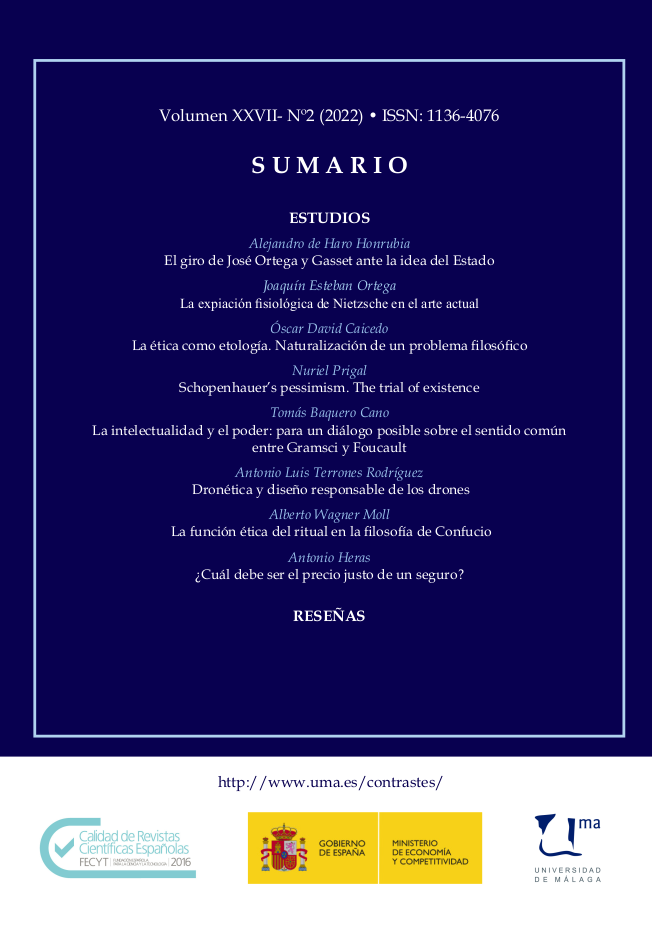¿Cuál debe ser el precio justo de un seguro?
DOI:
https://doi.org/10.24310/Contrastescontrastes.v27i2.13045Palabras clave:
Equidad actuarial, esperanza matemática, incertidumbre compartida, contractualismoResumen
Tradicionalmente, las primas de los contratos de seguros se han considerado justas o equitativas cuando se corresponden exactamente con el riesgo de las pólizas, medido este último mediante la esperanza matemática de la siniestralidad. En este artículo llevamos a cabo una crítica de este enfoque aparentemente objetivo y proponemos una justificación alternativa de la denominada equidad actuarial, basada en argumentos contractualistas. Para ello nos apoyamos en ciertas intuiciones de Jean Domat, un jurista francés del siglo XVII, acerca de la incertidumbre compartida, integradas dentro del marco general proporcionado por la teoría contractualista del economista y filósofo contemporáneo Robert Sugden.
Descargas
Métricas
Publicación Facts
Perfil de revisores N/D
Información adicional autores
Indexado: {$indexList}
-
Indexado en
- Sociedad Académica/Grupo
- N/D
- Editora:
- Universidad de Málaga
Citas
Ashford, E., & Mulgan, T. (2018). Contractualism The Stanford Encyclopedia of Philosophy (Summer 2018 Edition). Retrieved from https://plato.stanford.edu/archives/sum2018/entries/contractualism/
Baker, T. (1993). Constructing the insurance relationship: Sales stories, claims stories, and insurance contract damages. Tex. L. Rev., 72, 1395.
Ceccarelli, G. (2001). Risky business: Theological and canonical thought on insurance from the thirteenth to the seventeenth century. Journal of Medieval and Early Modern Studies, 31(3), 607-658.
Chan, C. S.-c. (2009). Creating a market in the presence of cultural resistance: The case of life insurance in China. Theory and Society, 38(3), 271-305.
Daston, L. (1988). Classical probability in the Enlightenment. Princeton, N.J.: Princeton University Press.
Domat, J. (1689). Les Loix civiles dans leur ordre naturel Paris: J. B. Coignard.
Domat, J., & Cushing, L. S. t. (1689/1850). The civil law in its natural order. Boston: Charles C. Little and James Brown.
Ewald, F. (1991). Insurance and risk. In G. Burchell, C. Gordon, & P. Miller (Eds.), The Foucault effect: Studies in governmentality (pp. 197-210). Chicago: University of Chicago Press.
Ewald, F. o. (1986). L'Etat providence. Paris: B. Grasset.
Hájek, A. (2007). The reference class problem is your problem too. Synthese, 156(3), 563-585.
Hald, A. (1990). A history of probability and statistics and their applications before 1750. New York: Wiley.
Halley, E. (1693). An Estimate of the Degrees of the Mortality of Mankind. Phil. Trans. , January 1(17), 596-610.
Heras, A.J., Pradier, P.Ch., & Teira, D. (2020). What was fair in actuarial fairness? History of the Human Sciences, 33(2), 91-114.
Kosinski, M., Stillwell, D., & Graepel, T. (2013). Private traits and attributes are predictable from digital records of human behavior. Proceedings of the national academy of sciences, 110(15), 5802-5805.
Kvalnes, Ø. (2011). Blurred promises: Ethical consequences of fine print policies in insurance. Journal of Business Ethics, 103(1), 77-86.
Landes, X. (2015). How Fair Is Actuarial Fairness? Journal of Business Ethics, 128(3), 519-533. doi:10.1007/s10551-014-2120-0
Lehtonen, T.-K., & Liukko, J. (2011). The Forms and Limits of Insurance Solidarity. Journal of Business Ethics, 103(1), 33-44.
Lehtonen, T.-K., & Liukko, J. (2015). Producing solidarity, inequality and exclusion through insurance. Res publica, 21(2), 155-169.
Lesch, W. C., & Brinkmann, J. (2011). Consumer insurance fraud/abuse as co-creation and co-responsibility: A new paradigm. Journal of Business Ethics, 103(1), 17-32.
O'Neil, C. (2018). Armas de destrucción matemática : cómo el big data aumenta la desigualdad y amenaza la democracia. Madrid: Capitan Swing.
Ogborn, M. E. (1962). Equitable Assurances. London: George Allen & Unwin.
Park, S. C., & Lemaire, J. (2013). The Impact of Culture on the Demand for Non-Life Insurance. ASTIN Bulletin, 42(2), 501-527.
Pascal, B., (1963). Œuvres complètes. New York: Macmillan.
Ribeiro, R., Silva, B., Pimenta, C., & Poeschl, G. (2020). Why do consumers perpetrate fraudulent behaviors in insurance? Crime, Law and Social Change, 73(3), 249-273.
Soto, D. d., (1556/1967). De la justicia y del derecho: en diez libros. Madrid: Instituto de Estudios Políticos.
Sugden, R. (2018). The community of advantage. Oxford: Oxford University Press.
Teira, D. (2006). On the normative dimension of the St. Petersburg paradox. Studies in History and Philosophy of Science Part A, 37(2), 210-223.
Thaler, R. H. (2015). Misbehaving : the making of behavioral economics. New York: W.W. Norton & Company.
Turnbull, C. (2016). A history of British actuarial thought. New York, NY: Springer Berlin Heidelberg.
Zelizer, V. A. (1978). Human values and the market: The case of life insurance and death in 19th-century America. American journal of sociology, 84(3), 591-610.
Zourrig, H., & Park, J. (2019). The effects of cultural tightness and perceived unfairness on Japanese consumers’ attitude towards insurance fraud: the mediating effect of rationalization. Journal of Financial Services Marketing, 24(1), 21-30.
Descargas
Publicado
Cómo citar
Número
Sección
Licencia
Esta revista provee acceso libre inmediato a su contenido bajo el principio de hacer disponible gratuitamente la investigación al público. Todos los contenidos publicados en Contrastes. Revista internacional de Filosofía, están sujetos a la licencia Creative Commons Reconocimento-NoComercia-Compartirigual 4.0 cuyo texto completo puede consultar en <http://creativecommons.org/licenses/by-nc-sa/4.0>
Es responsabilidad de los autores/as obtener los permisos necesarios de las imágenes que están sujetas a derechos de autor.
Los autores/as cuyas contribuciones sean aceptadas para su publicación en esta revista conservarán el derecho no exclusivo de utilizar sus
contribuciones con fines académicos, de investigación y educativos,
incluyendo el auto-archivo o depósito en repositorios de acceso abierto de cualquier tipo.
La edición electrónica de esta revista esta editada por la Editorial de la
Universidad de Málaga (UmaEditorial), siendo necesario citar la procedencia en cualquier reproducción parcial o total.










5.png)
